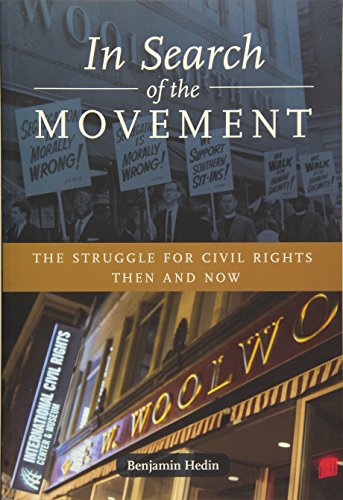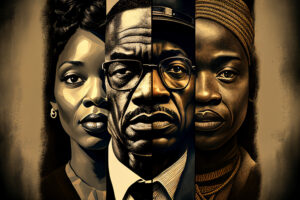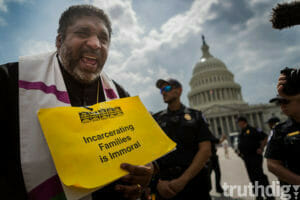In Search of the Movement
Honoring Black History Month, Truthdig takes a look at a book that asks: Now that today's public schools are more racially segregated than in the ’60s, now that black men and women are being gunned down by police at alarming rates, and now that black men are six times more likely than white men to be behind bars, "What happened to the civil rights movement?"
“In Search of the Movement: The Struggle for Civil Rights Then and Now” A book by Benjamin Hedin To see long excerpts from “In Search of the Movement” at Google Books, click here.
The 1963 March on Washington. The 1964 Civil Rights Act. The 1965 Voting Rights Act.
The past three years have witnessed numerous 50th anniversary commemorations of key moments in the civil rights movement, marked by commemorative marches in Washington and Selma, vibrant cultural performances, and even an oration by President Barack Obama from the very spot where Martin Luther King Jr. delivered his iconic “I Have a Dream” speech.
And yet these same three years have witnessed severe setbacks for racial justice.
The 2013 United States Supreme Court decision in Shelby County v. Holder eviscerated the heart of the Voting Rights Act: 21 states subsequently erected obstacles blocking the path to the voting booth for people of color, from North Carolina to Texas to Ohio.
A national survey by the UCLA Civil Rights Project reveals that today’s public schools are more racially segregated than in the 1960s, with students of color more likely to attend majority-minority schools than those in the generation before them were.
The harshest news is from the criminal justice system: The NAACP documents that African-American men are six times more likely than whites to be behind bars. That statistic, combined with this year’s heartbreaking headlines about so many black men and women killed by police, can make even the most optimistic wonder if we have made any progress at all toward racial equality.
These are the tragic contradictions that compelled author Benjamin Hedin to ask what happened to the civil rights movement. In his new book, “In Search of the Movement: The Struggle for Civil Rights Then and Now,” the author literally goes on a quest to seek the answer.
Hedin interviewed more than 100 people, from the well-known to the unknown. They include: the late Julian Bond, a student activist who became a member of the Georgia Legislature and chair of the NAACP; Rep. John Lewis, who in 1965 was bloodied by Alabama state troopers on the Edmund Pettus Bridge during the Freedom March from Selma; and unsung heroines like Septima Clark and Bernice Robinson, who brought literacy to the remote Johns Island, where most blacks worked as “virtual slaves” on rice and cotton plantations. Hedin also interviewed those who are active today, like the Rev. William Barber, who founded Moral Mondays in response to the massive rollback of rights by the North Carolina Legislature, and the youths who organized Dream Defenders in response to the killing of Trayvon Martin in Florida. And there are others, like Robert Moses and David Dennis, who are no longer in the spotlight but never ceased their activism and passion for justice. Moses and Dennis faced the violence of white vigilantes in the Freedom Rides and voter registration drives of the ’60s and now run the Algebra Project, a national nonprofit using mathematics to promote quality education for all children.
There have been many excellent books written about the civil rights movement, like Taylor Branch’s comprehensive trilogy, “America in the King Years,” and recent ones addressing racial oppression today, such as Michelle Alexander’s groundbreaking “The New Jim Crow: Mass Incarceration in the Age of Colorblindness.” So what motivated Benjamin Hedin, a young white man who was born after the key events in this book? And what does “In Search of the Movement” add to this substantial body of literature?
Hedin takes us along on his journey, acknowledging his innocence and his (sometimes quite erroneous) assumptions. With equal parts curiosity and humility, he intertwines history and current events with his own thoughtful reflections. After scores of interviews and many thousands of miles clocked on the odometer, he slowly comes to feel that he “had gotten a glimpse into the heart of things, as if a panel had been lifted and I could see the gears and knobs, all the workings that made the machine go.”
Hedin, who has written for The New Yorker, The Nation and the Chicago Tribune, and who edited the highly praised “Studio A: A Bob Dylan Reader,” is an eloquent and candid writer.Best of all, Hedin gives a great amount of space to the people he interviewed. Their memories from decades ago are vivid, including those of the quotidian tasks that made the grander moments of the movement possible.
We learn about the Colleys, African-American parents of six children, who used one of their three bedrooms to house two Freedom Summer volunteers from the North — one black, one white — at great risk to themselves. And one elderly woman who organized a shoe donation drive for those who had to walk miles to work during the Montgomery Bus Boycott.
We also hear from their counterparts today, like Jesse Tyler, who travels around Mississippi making house calls to the poorest of the poor and helping them sign up for health insurance. Since Mississippi is one of the states that refused to expand Medicaid after the passage of the Affordable Care Act, there are many who cannot qualify. “Every day I come home,” Tyler explains, “I just get madder at the system.”
Yet she continues to knock on doors, cajole churches to lend their vans and buses for the effort, and study the fine print of the regulations, knowing that she just won’t “leave them out there in the cold.”
One of the most poignant stories is one that “transpired without much notice,” Hedin writes. Septima Clark and her cousin Bernice Robinson set up a citizenship school on South Carolina’s Johns Island. It was the mid-1950s, around the same time as the Montgomery Bus Boycott, the showdown over the admission of the first black students at Central High School in Little Rock, and the U.S. Supreme Court’s Brown v. Board decision. Yet the story of Clark and Robinson’s school is unfamiliar to most.
Hedin calls it a story of the “guerrilla” or “underground” variety of organizing, but warns that it should not be deemed “secondary or alternate.”
After the 1954 Brown decision, Southern politicians aimed to destroy the NAACP. South Carolina passed a law banning all state workers — including teachers — from belonging to the organization. Clark, who was both an NAACP organizer and a teacher in South Carolina, lost her job. With the support of the Highlander Center in Tennessee, an interracial training school for union, community and civil rights organizers that Clark attended after being fired in South Carolina, she and Robinson set up classes called “Education for Citizenship,” focusing on the election and voting laws of South Carolina, on Johns Island. They taught literacy and practical preparation for registering to vote, including mastering some of the more obscure words, like “fornication,” “larceny” and “elector” found in the archaic vocabulary of the state constitution.
The work of Clark and Robinson, along with the freedom schools and citizenship classes that were modeled on it all around the South, played a major role in gaining both literacy and voting rights for blacks. Hedin argues convincingly that the reason Johns Island school is not written about much is because organizing at that level does not have as much drama as a mass march or defying police truncheons.
“Organizing … is a compound of meetings and interactions spanning several years across a region, and given these traits — its amorphousness and undramatic character — it can’t help but get lost, for generally it offers nothing for the popular imagination to seize on,” Hedin concludes.
This holds true for today’s narratives as well, Hedin writes. The national impact of Black Lives Matter and the resurgence of black activism on college campuses in recent months bolster Hedin’s argument that that the civil rights movement was not one dramatic moment, but an ongoing story of dedicated, passionate, creative people willing to do both the grand and the day-to-day hard work of fighting for social and racial justice.
Though he clearly admires the people he has interviewed, Hedin does not idealize the movement of 50 years ago or its expressions today. The book provides its fair share of disappointment, setbacks and internal divisions, some of them racialized. One cannot help, however, but come away from these pages with a feeling of hope. By tying the early civil rights organizers to the anti-racism activists of today, Hedin builds a strong case for the movement as a continuum. The anniversary celebrations do not merely celebrate the heroes of the past, but provide inspiration to those who face the challenges today.
Perhaps it is Julian Bond, who died in August at age 75, who gives voice to the most important lesson in Hedin’s book. When asked by Hedin how he would characterize the civil rights movement for his college students, Bond replied: “I say that it continues on and on. I don’t tell them that King got killed and it ended. … The movement is not something that happened way back then. I may start talking about it in a way-back-then period, but I tell them it’s going on in the current time.”
Elaine Elinson is the coauthor of “Wherever There’s a Fight: How Runaway Slaves, Suffragists, Immigrants, Strikers and Poets Shaped Civil Liberties in California” (Heyday), which won a gold medal in the 2010 California Book Awards.
Your support matters…Independent journalism is under threat and overshadowed by heavily funded mainstream media.
You can help level the playing field. Become a member.
Your tax-deductible contribution keeps us digging beneath the headlines to give you thought-provoking, investigative reporting and analysis that unearths what's really happening- without compromise.
Give today to support our courageous, independent journalists.







You need to be a supporter to comment.
There are currently no responses to this article.
Be the first to respond.